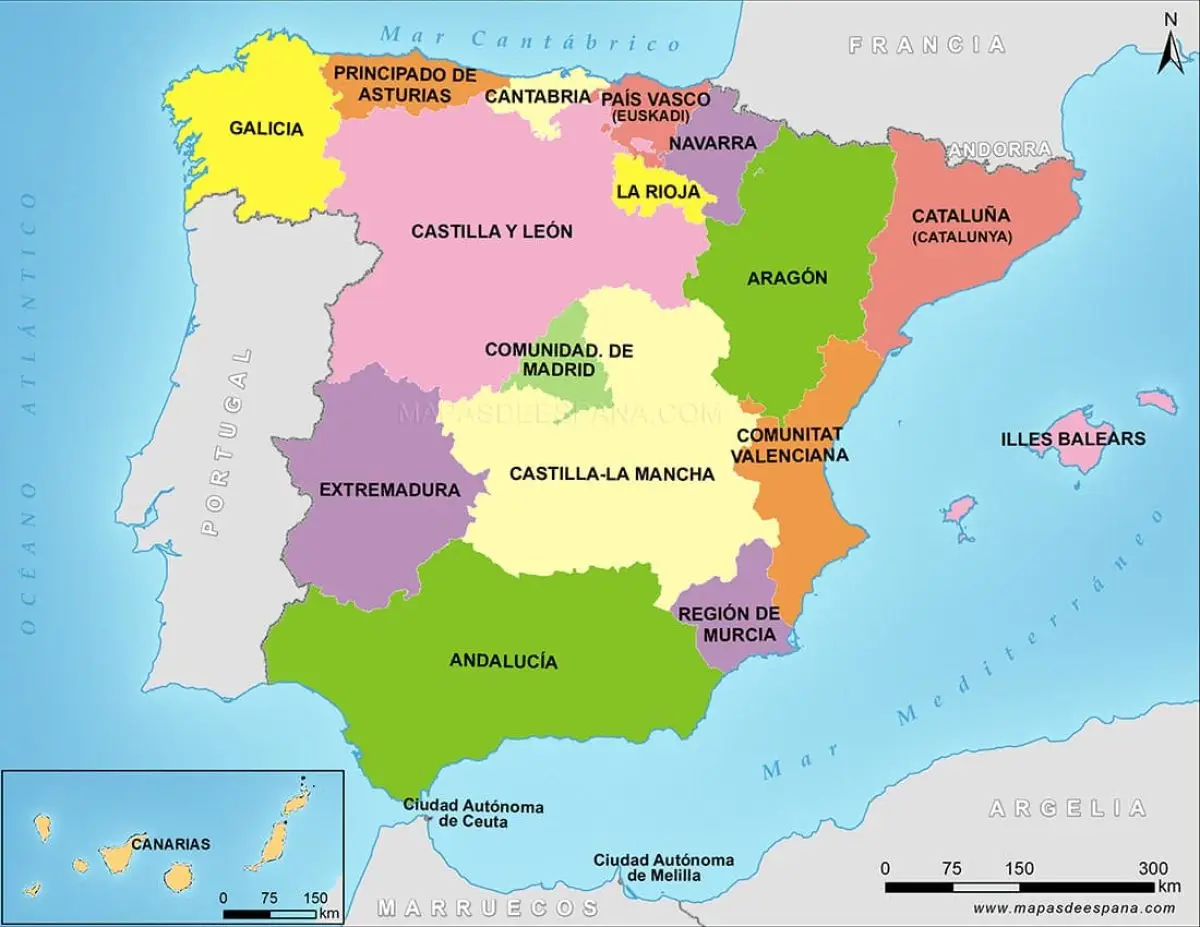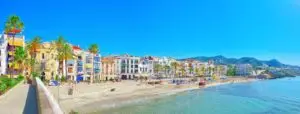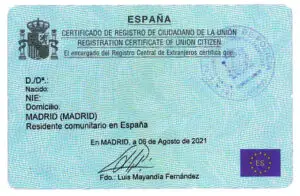
Regions of Spain
Spain has it all: world famous, cosmopolitan cities, beautifully quaint villages, remote countryside, mountain ranges, lakes and beaches. It’s also a highly devolved country where different regions have different rules for some important areas, such as inheritance tax. If you are new to Spain, you can read a general overview here about the different regions of Spain, to point you in the right direction for further research.
On this Page
Regions of Spain: The most popular with foreign residents
Although we wouldn’t suggest you just follow everybody else, there is something to be said for areas that are popular with other foreigners. For one thing, there’s usually a reason they are popular: they have a lot to offer. For another, it usually means that there will be a good support network for you personally, and a range of services (including international schools) that are set up for, or at least used to dealing with, foreign residents. Here are the regions where most foreign residents have set up home in Spain:
Andalucia (Cádiz, Granada, Malaga, Marbella, Sevilla & more!)
Overview: When a lot of people imagine Spain and Spanish culture, they are really imagining Andalucia. Think flamenco, siestas, fiestas and sangria. But although the typical Andalucian culture is alive, kicking, and wonderful, the region has a lot more to offer besides. From Europe’s best spot for windsurfing/kitesurfing at Tarifa, to skiing near Granada. And from millionaire playgrounds like Marbella and Puerto Banus, to hippy communes in Orgiva. You can find sweltering beaches on the Mediterranean in Malaga, or the Atlantic in Cadiz; desert in Almeria, and lush, water filled countryside near Ronda or Lanjaron.
Popular places for foreigners to live: There are too many to list here. As well as the cities, look at La Herradura, Salobreña, Estepona, Fuengirola, and Almuñecar on the coast, or the green mountainous landscapes of Las Alpujarras inland. Like elsewhere in Spain, there is a considerable range in climate depending on altitude, so that mountainous Granada at 738m above sea level, for example, will have higher temperatures in summer but will be a lot less humid than coastal Motril, only 50 minutes away by car. In winter, temperatures will be lower in Granada but it will be a drier cold. Note, also that the climate varies considerably between the Atlantic coast (Costa de la Luz, roughly from Gibraltar to Portugal) which is often very windy and has cooler water to swim in, and the Mediterranean Costa del Sol, which has warmer water and is much less windy. There is also a difference in topography between Almeria (which is desert like but includes lovely little towns like Mojacar) and other parts, which can be quite lush.
International Airports: Malaga is the busiest, with regular flights all over Europe and to Newark, USA, plus seasonal routes to several Middle Eastern destinations. There are also international airports in Cádiz, Granada and Seville.
Pros: It’s the Spain of legend, with everything you imagine about Spain, and much more besides.
Cons: Some areas are overwhelmed with expats living the dream. Temperatures can be high in summer. There has been noise in the press about people discovering their rural properties are illegal. However, the AFO system should help with this.
Balearic Islands (Mallorca, Menorca & Ibiza)
Overview: Mallorca was the first package tour destination for northern Europeans and a couple of its resorts, notably Magaluf, have a reputation as havens for bad behaviour. However the rest of the island couldn’t be more different. It is beautiful and its capital, Palma, punches well above its weight in terms of shops, restaurants and things to do. It’s also a year round place, whereas Menorca & Ibiza are much quieter out of season. Menorca has some stunning Georgian architecture (a legacy from British rule) and stunning rugged coves and a vibrant sailing community in season. Ibiza is internationally famous as a hedonistic mecca for dance music enthusiasts, but outside the main areas for that (San Antonio, Playa d’en Bossa, San Rafael) it’s a stunningly beautiful, timeless jewel with a laid back, open minded vibe.
Mallorca, as its name suggests, is the largest of the islands, at 3640km2 & with a year round population of about 1 million. Menorca is next size-wise, at 695km2, but with a smaller year round population than Ibiza, at around 100,000. Ibiza has the smallest area, at 570km2, but has a year round population of around 150,000. There is another island in the Balearics called Formentera, but whilst very popular for day trips, it’s a protected area and not a place to set up your year round residence.
Popular places for foreigners to live: In Mallorca: Palma, Palmanova, Deia. In Menorca: Mahón, Ciutadella, Fornells. In Ibiza: well, the whole island is popular. Housing is expensive & can be difficult to come by, so the best answer might be ‘wherever you can’.
International Airports: Palma de Mallorca & Ibiza have year round international flights. In Menorca, you may find international flights only in summer (the rest of the year, you would fly to another Spanish airport and then take an internal flight or boat to Menorca).
Pros: Island life means crystal clear waters and beautiful beaches are never far away, for great swimming & watersports. Palma is a great year round city, one of the most dynamic in Spain and has more to offer than most cities of its size.
Cons: Food etc can be more expensive if it comes from outside the island. The islands can feel overrun with people in the summer season. It can be expensive to get off the islands to the rest of Spain if you do it a lot, although there are discounts on flights to the mainland if you are resident in the Balearics.
Canary Islands (Gran Canaria, Lanzarote, Tenerife)
Overview: The Canaries are actually off the coast of Africa, so they have different weather from the rest of Spain (a sub tropical climate which is generally sunny, warm and windy all year) and a different time zone (the same as Portugal & the UK). There are 7 main islands, of which the most popular to live are Tenerife, Fuerteventura, Gran Canaria, Lanzarote & La Palma. There are many great beaches, but the sea is the Atlantic, a quite different experience from the calm Mediterranean vibe of most of Spain’s beaches.
Popular places for foreigners to live: Tenerife is the most populated, with around a million inhabitants, followed closely by Gran Canaria. There’s then quite a jump to Lanzarote and Fuerteventura, which each have around 150000 inhabitants. La Palma has about 85,000 inhabitants.
International Airports: Each of the most populated islands has international flights from European cities and internal flights from other parts of Spain. The busiest airports and the ones served by the most European cities are Tenerife and Gran Canaria. For smaller islands you need to get connecting flights from one of the larger islands.
Pros: Lovely weather all year round. Great local fruit & vegetables. Wonderful outdoor lifestyle.
Cons: You can feel cut off. From the Balearic islands, you can fly to the mainland in 25 mins. From the Canaries, to get to mainland Spain will take you around 2.5hrs. As with other parts of Spain, if you have an income from outside the country you can live quite well. But if you are counting on finding work once there, you will face tough competition for scarce jobs that may not be very well paid. Some people find the laid back lifestyle can get boring after a while.
Catalonia (Barcelona, Girona, Tarragona & More!)
Overview: This stunning Mediterranean region bordering France has great food, amazing countryside, and of course, Barcelona. There’s a noticeable difference in culture from other parts of Spain, too. Not just due to the widespread use of the Catalan language (which, in various dialects, can be found in the Valencia region and the Balearics, too) but also because of a alleged slightly more dynamic pace of life. Some Catalans like to see themselves as half way between the Spanish & the French in this respect. There may be some truth in this.
Popular places for foreigners to live: Barcelona, Cambrils, Castelldefels, Girona, Sitges, Platja D’Aro, Palamós, Tarragona
International Airports: Barcelona and, to a lesser extent, Tarragona (Reus) & Girona
Pros: Great food, great connections with the rest of Europe & Spain, wonderful beaches, easy access to some of the best skiing in Spain (in the Catalan Pyrenees & Andorra) great cultural offerings in Barcelona, and some jobs too (eg pharmaceuticals, tech/design).
Cons: You can feel excluded from Catalan society if you don’t speak Catalan. On the other hand, when you start to learn & try to practise, you. may well be answered in Spanish or English. But in Barcelona, Spanish is just as widely spoken as Catalan, if not more so. All schooling is in Catalan,except international schools. The one language you won’t find schooling in is Spanish! However, most expats who send their kids to local schools find that they come out speaking Spanish as well as Catalan, because Spanish tends to be the language of the playground. The independence sentiment can sometimes get to the point where there’s a palpable tension in the air. But it seems to have dissipated somewhat in the years since the pandemic.
Madrid
Overview: Where Barcelona has the sea; Catalan architecture & food; & proximity to France, Madrid feels more like the centre of all things hispanic. Not only because it is deliberately located to be 3hrs by car or train from almost anywhere in Spain, but also because it is a melting pot for Spanish speakers from everywhere. It is a very lively city, with lots of job opportunities in international companies, and plenty on offer to see and do. Being located at 657m altitude in the middle of a land mass, Madrid has fairly hot summers & cold winters, with temperatures reaching the mid 30’s (centigrade) in summer and around zero in winter. There is skiing near Madrid in winter, and there are rivers, lakes & large pools to cool off in summer, though most Madrileños will head to the coast in August.
Popular places for foreigners to live: Naturally this depends on your interests and budget, but popular barrios of Madrid include Chueca (large LGBTQ community, trendy bars & cafés, lots going on for young adults); Malasaña (another fun, trendy, lively and cheaper one for young adults); Lavapies (also cheaper, multicultural); Retiro (more expensive, large park with lakes, galleries & museums); La Latina (old, traditional buildings, artists, reasonably expensive); and Salamanca (a safe, more high brow neighbourhood with more expensive housing and a well-heeled, older vibe).
International Airports: Madrid’s main airport is called Adolfo Suárez
Pros: Fun for young adults & great for culture lovers. For those who speak Spanish, more accessible than Barcelona as you’ll never feel shut out by people speaking Catalan (or jobs requiring it). Plenty to see & do and very well connected by road, high speed rail & flights to the rest of Spain. Within 3 hours you can be in Barcelona, Valencia, or Granada.
Cons: Some people find the temperatures to be extreme, with cold winters & hot summers, though the cold is dry & the heat is not humid. It’s a lively, noisy city where the locals don’t seem to sleep much; they go to bed very late & get up early.
Valencia (Alicante, Denia, Javea, Valencia & More!)
Overview: Long popular with residents from colder climes, this region boasts Valencia itself, which is currently one of the trendiest cities in Spain, and, according to some, ‘like Barcelona before it was ruined by tourists’. Dotted all down the coast are towns favoured by expats, although some (like Benidorm) are not the most architecturally beautiful in Spain.
Popular places for foreigners to live: Alicante, Altea, Benidorm, Calpe, Denia, El Campello, Javea, Moraira, Torrevieja Valencia (city)
International Airports: Valencia & Alicante
Pros: The area itself is beautiful, with great cuisine (Valencia is the home of Paella) and plenty of entertainment on offer in Valencia and Alicante. Great connections: a 3-4hr drive will take you to Barcelona, Madrid or Andalucia. A ferry ride will take you to Ibiza. Valencia is currently a happening place for younger adults.
Cons: Although nothing like as pronounced as it is in Catalonia, there is a movement to promote the use of the regional language (Valenciano, which is basically a dialect of Catalan, though we wouldn’t recommend telling a Valencian this!). In public schools, for example, 30-50% of subjects may be taught in Valenciano (compared to 100% in Catalan in Catalonia). However, there isn’t really an independence movement to speak of, although you will find it necessary to learn Valenciano if you want a job in the public sector. There have been a lot of cases of illegally built properties in the Valencia region (as with Andalucia). This mainly affects properties built on land designated as ‘rural’ (this could be on the edge of a village, not necessarily in the middle of nowhere). Have a good lawyer check documentation carefully before you buy. Some towns (Javea, Benidorm, etc) are slightly overrun with northern European residents, though this may be an advantage,depending on your perspective.
Regions of Spain: Popularity Rising
Water restrictions, summer temperatures above 40 degrees centigrade, too many fellow expats…these are some of the reasons that more foreign residents have begun to explore the possibility of life in ‘green Spain’. On the other hand, for those who cannot do without sun & want their money to go further, previously unfashionable Murcia has become more attractive in recent years.
Asturias, Cantabria & Galicia ('Green Spain'/Northern Spain')
Overview: Green Spain / Northern Spain technically includes Pais Vasco (Basque Country/Euskadi) as well, but it is Asturias, Cantabria & Galicia that seem to be attracting increased numbers of expats recently. Expats are being lured to this part of Spain by a cooler climate, stunning scenery, the absence of a water crisis, and more attractive prices for housing. The climate is much rainier than the rest of Spain, but very pleasant in summer and, unless you are at high altitude, the winter temperatures are mild. The beaches are beautiful, but the Atlantic is rougher and cooler than the Mediterranean. There are fewer expats, so fewer amenities set up for them. However, you will find delicious food, friendly locals, and wonderful traditions that you’ll be invited to join in on.
Popular places for foreigners to live: Quite a few foreigners interested in living off the grid or homesteading have headed to the area, & they can be found dotted all over.
In terms of cities, in Asturias, Gijon is a beautiful coastal town, whereas Oviedo is a lively university town with plenty of nightlife for young adults. Asturias’ other city, Aviles, is more industrial, and there have occasionally been warnings about the air quality for those living nearby. In Cantabria, Santander has regular direct ferries to the UK, good food, drink & outdoor activities, and only Spanish is spoken in schools & elsewhere (Asturias & Galicia both have regional languages). In Galicia, popular urban choices for expats are A Coruña ( a mid sized, walkable, beach city with amenities, Santiago de Compostela (lots of tourists because of the famous pilgrimage ‘Camino de Santiago’) and Vigo ( increasingly popular with foreigners, high speed trains to Madrid, 90mins by car from Porto, Portugal. The area south of Vigo, heading to Portugal, is called Baixo Minho and has a fair number of foreign retirees, due to it having the best climate in Galicia)
International Airports: Asturias international airport is in Castrillón, & has mainly domestic flights, with some scheduled international flights in summer. Cantabria´s only international airport is the Seve Ballesteros airport in Santander, which has a few European routes (mainly to the UK) and domestic routes. In Galicia, there are international airports in A Coruña (mostly domestic with some scheduled European flights), Santiago de Compostella (the busiest in Galicia with regular flights to several European cities as well as domestic locations) and Vigo (mostly domestic flights with occasional scheduled flights to European cities)
Pros: Cooler summers, lush, green, virgin landscape with no water shortages, welcoming, traditional cultures, excellent food & drink, especially seafood. More reasonable property prices than other parts of Spain. Not so many tiger mosquitoes (yet) as the rest of Spain. Great surfing on the Atlantic coast.
Cons: Winters can be dreary with a lot of cloud and rain. Towns and villages can be sleepy. Asturias and Galicia have schooling in the regional languages as well as Spanish. The beaches are beautiful but the Atlantic water can be very cold compared to the Mediterranean, even in summer.
Murcia
Overview: In stark contrast to ‘green Spain’ is Murcia, a dry, dusty land of desert & beach towns with its own exotic charm. Nestled between Alicante and Almeria (Andalucia), properties & living costs can be cheaper here, and the Costa Calida beaches reputedly offer the warmest water in Spain.
Popular places for foreigners to live: The main cities are Murcia city and Cartagena. Murcia has a range of expats, as well as international schools , good healthcare & other amentie. Cartagena is pleasant enough, with a good range of shops (and a Spanish naval base). Other popular areas are Los Alcázares (on the Mar Menor, Europe’s largest salt water lagoon, popular with retirees), La Manga (lots of watersports & golf), Lorca (a historical city with a low cost of living), Torre Pachecho (good for golfers & beach lovers) and Molina de Segura ( a residential area with good links to Murcia city; good for families).
International Airports: Murcia International Airport has domestic flights & regular flights to several major European countries. Alicante airport is only an hour or so from Murcia city, and offers more European destinations.
Pros: Great year round weather. Lower cost of living than some parts of Spain. Not yet overwhelmed with foreign residents. Easy to get to Alicante or down to Andalucia.
Cons: If you go with kids, they might find it a bit less than dynamic once they get to a certain age. Not much in the way of jobs in the local economy. Culturally less exciting than some parts of Spain. Great if you are a digital nomad or have a pension or want a quiet and very pleasant life in the sun.
Regions of Spain: The less frequented parts
The rest of Spain should not be overlooked, although you are not likely to find many other expats or many amenities set up for foreign residents.
Aragon, Castilla y Leon, Castilla La Mancha, Extremadura, Navarra, La Rioja, Pais Vasco (Basque Country)
Overview: It is difficult to generalise about these areas as they are so diverse. However, what they do have in common is that there are relatively few foreigners living there, so it will be harder to find people from your country to talk to, or to find amenities such as international schools. Aragon, Navarra & The Basque Country all have the beautiful Pyrenees mountain range in their territory. Aragón has the friendly university town of Zaragoza. Also, if you follow the river Ebro from its estuary (in Catalonia) inland, you find quite a few international off gridders, including where Catalonia turns into Aragon. Castilla y León has the wonderful, historical university town of Salamanca, which is always full of students from across Europe & the world, as well as a host of other medieval towns, great traditional Spanish food & traditions, & an easy going way of life. Castilla la Mancha is the land of Don Quijote & Manchego cheese, has beautiful UNESCO world heritage site & city, Toledo, which has excellent & fast connections to Madrid. The Basque Country (known locally as Euskadi) has the Atlantic coast; the beautiful city of San Sebastian (Donostia); the bustling, friendly industrial port of Bilbao; and probably the best food in Spain (don’t tell the Catalans!). It also has its own language which, unlike other regional languages in Spain, is not closely related to Spanish at all, and which is used in schools. To add to this, there is a strong independence sentiment in some quarters. Extremadura has a reputation (perhaps from the name) for being a harsh, barren land, but in some parts, the opposite is true. Areas such as La Vera are teeming with water and lush landscapes, and property with land can still be had for very reasonable prices. Culturally, it is not necessarily a dynamic region, although there are first rate Roman ruins in Mérida. Navarra is beautiful, largely undiscoverd by foreign masses, and has Pamplona, a fun & lively university town where you will definitely not be the only expat. Finally, La Rioja isn’t only home to Spain’s most famous wines, it also has Logroño, with a small expat community, and welcoming people who are not yet tired of foreigners!
Popular places for foreigners to live: None of these regions is what you might call popular with foreigners (compared to other parts of Spain) although you’ll find reasonable numbers of other expats to talk to in Bilbao, San Sebastian, Pamplona, Salamanca and Zaragoza.
International Airports: Aragon: Zaragoza airport has regular flights to some European destinations as well as domestic routes. Castilla y León: In practice you will take international flights from Madrid, up to 2 hrs away. There are domestic flights from Salamanca and Valladolid. Castilla La Mancha: Take flights to & from Madrid, up to 2hrs away by train or road. The Basque Country: Bilbao airport has regular flights to many European destinations plus some to Egypt. San Sebastián usually has flights to the UK as well as domestic routes. Extremadura: for international flights you’re likely to go by train or road to Madrid, Seville or even Lisbon, depending on where you are located. Badajoz airport has some domestic routes. Navarra: You will need to take flights to & from Bilbao, some 3.5hrs by road, or else from Biarritz or San Sebastián. Pamplona serves some domestic routes only. La Rioja: You will need to travel 3.5hrs to Bilbao to take international flights, as Logroño airport only serves a couple of domestic routes.
Pros: These are the places to go if you want to immerse yourself with the locals, and to find that they are probably interested in you because they don’t see thousands of foreigners each year as in other parts.
Cons: It could get lonely when you get older (or for your kids once they reach teenage years) if you don’t have many people around who you can kick back with in your own language and who understand the cultural references you make.
Regions of Spain: Tax considerations
Maybe it won’t be the main reason you choose one region over another, but the tax issue is something to. bear in mind. For example, if you buy a property in Catalonia, you will likely pay 10% of the property price in taxes on the purchase, and if you die and leave the property to your partner or children, your partner will pay inheritance tax ranging from 7-34% on any value over €100k. If you do the same things in Andalucia, you’ll pay 7% when you purchase the property, & your spouse/children will pay no inheritance tax on any value up to €1 million. So, choosing Andalucia over Catalonia could save you & your family hundreds of thousands of euros in taxes. Meanwhile, 50% of the income tax you pay will be decided by the Spanish state, whereas the other 50% is decided by the region you live in, so there are variations there, too. In Andalucia, adding the state & regional portions together gives you a range from 19% (up to €12,450) to 48.2% (over €120k) whereas in Catalonia, you will pay a range from 21.5% (up to €17.7k) to 50% (over €175k)
Income tax
To work out your income tax liability in different regions, you have to add state income tax rates (responsible for 50% of what you pay) and regional rates (responsible for the other 50%)
In 2024 the results of these two portions added to together were as follows:
- Andalucia: From 19% (up to €12450) to 48.2% (from €120k)
- Aragon: 19.5% (up to 13,072.50 euros) to 49.5% (over €130k)
- Asturias : 19.5% (up to €12,450) to 50% (over €175k)
- Balearic Islands : Between 19% (up to €10k) and 49.5% (over €170k)
- Basque Country : From 23% (up to €15,500) to 49% (over €179,460)
- Canary Islands : Between 18.5% (up to €12450) and 50.5% (over €90k).
- Cantabria : Between 19% (up to 12450) and 50%. (over €90k)
- Castilla y León : 19% (up to 12450) to 46%.(over €53,407)
- Castilla-La Mancha : In Castilla-La Mancha the personal income tax rates are the same as those set by the State.
- Catalonia : From 21.5% (up to €17,707) to 50% (over €175k).
- Extremadura: Between 19% (up to €12,450) & 49.5% (over €120k).
- Galicia : Between 19% (up to €12,450) and 47% (over €60k).
- La Rioja : From 18.5% (up to €12450) to 51.5% (over €120k).
- Madrid: Between 18.5% (up to €13,362) and 45.5% (over €57,320).
- Murcia : From 19.3% (up to €12450) to 47.6% (over €60k).
- Navarra: Between 13% (up t0 4,000 euros) and 52% (over €300k)
- Valencia: From 19.5% (up to €12450) to 54% (from €120k)
ITP (On Property Purchases)
The ITP is the tax you pay on the purchase price of a property (unless it is a newbuild, in which case you pay VAT, known as IVA). There are discounts in some regions, for example if you have 3 or more children in your care in Catalonia, you will pay 5% instead of 10%.
Andalucía | 7% |
Aragón | 8% |
Asturias | 8% |
Baleares | 8% |
Canarias | 6,5% |
Cantabria | 9% |
Castilla La Mancha | 9% |
Castilla y León | 8% |
Cataluña | 10% |
Ceuta | 6% |
Madrid | 6% |
Valencia | 10% |
Extremadura | 8% |
Galicia | 10% |
La Rioja | 7% |
Melilla | 6% |
Murcia | 8% |
Navarra | 6% |
País Vasco | 4% |
Inheritance Tax
There is a national law on inheritance tax, but the individual regions can then apply their own laws on top. This can result in significant change to the results for your heirs, depending on their degree of relationship to you.
The national law in 2024 stated the following rates:
- Inheritance up to €7,993: 7.65%
- €7,993–€31,956: 7.65 to 10.2%
- €31,956–€79,881: 10.2 to 15.3%
- €79,881–€239,389: 15.3 to 21.25%
- €239,389–€398,778: 25.5%
- €398,778–€797,555: 29.75%
- €797,555+: 34%
However, depending on where you live in Spain, this could be reduced to nothing for children, spouses & parents of the deceased, such as in:
- In Andalucia, so long as the net inheritance (after debts are paid off etc) is under €1 million
- In Aragón, so long as the net inheritance (after debts are paid off etc) is under €500k
- In Extremadura, so long as the net inheritance (after debts are paid off etc) is under €500k
- In La Rioja, so long as the net inheritance (after debts are paid off etc) is under €400k
In other regions, in 2024, it worked like this:
- Asturias: Children under 21 are exempt, as are spouses, for inheritances up to €300k
- Balearic Islands: Children, parents & partners are exempt. There is a 25% reduction in the state tax for inheritances from siblings, aunts & uncles
- Basque Country: Spouses, children & parents are exempt up to €400k, after which they pay 1.5%
- Canary Islands: Children, parents, spouses, siblings & uncles/aunts nephews/nieces have an exemption of 99.9% vis a vis the state tax
- Cantabria: Spouses, children and parents are 100% exempt for inheritances up to €100k, after which they pay from 1% to 10% depending on the amount
- Castilla y León: Spouses, children & parents have a 99% reduction on the state tax
- Castilla La Mancha: Children under 18, spouses & parents are exempt up to €300k. After this, they get an 80% reduction on the state tax
- Catalonia: Children under 21 are exempt up to €100k, plus an additional €12k for each year under 21 they are, up to a maximum of €196k
- Galicia: Spouses, children & parents are exempt up to €1 million
- Madrid: Spouses, parents & children receive a 99% reduction
- Murcia: Spouses, parents & children receive a 99% reduction
- Navarra: Spouses are exempt up to €250k, whereas children & parents pay 2-16% of the state tax, depending on the amount.
- Valencia: Spouses, children & parents receive a 99% reduction on the state tax
Wealth Tax
When you are resident in Spain, you can be taxed on your worldwide assets if they exceed a determined amount. This is known as the wealth tax. When you own a property in Spain but are not resident, you can still be subject to the wealth tax, but only on your assets located in Spain.
As is often the case in Spain, there is a national law, but autonomous regions are free to modify it. So, depending on where you live in Spain, your wealth tax liability could be quite different.
Wealth tax is subject to continuous change so it is best to consult with a professional. However, in very general terms we can say that if you do not have worldwide assets over €500k (per person if a couple), you do not need to worry about it. Even if you do, your advisory will tell you what kind of assets are taxable, what exemptions there are (eg for a portion of the value of your main residence) and where in Spain the threshold will be higher than €500k per person.
More articles that may be of interest:

The dreaded okupas/ squatters in Spain: The end in sight?
The end for Squatters in Spain? Nov-24 A new amendment to the law regarding squatters

Residency in Spain for EU citizens: our easy to follow guide
Residency in Spain for EU Citizens If you are an EU or EFTA citizen, you

Move to Spain -practical information to help make your move to beautiful Spain easy
Move to Spain If you’re thinking about a move to Spain, there’s quite a lot

Visit Spain – all the information you need for an easy stay in this beautiful country
Visit Spain Use this page to guide you to the information you need On this

EES Spain: Our easy to follow guide
EES Spain If you are wondering what the EES system is and how it will

How to get the green NIE (Certificado de Registro) An easy to follow guide
Get your ‘Green NIE’ (Certificado de Registro) The Certificado de Registro de Ciudadano de la
Share this page
